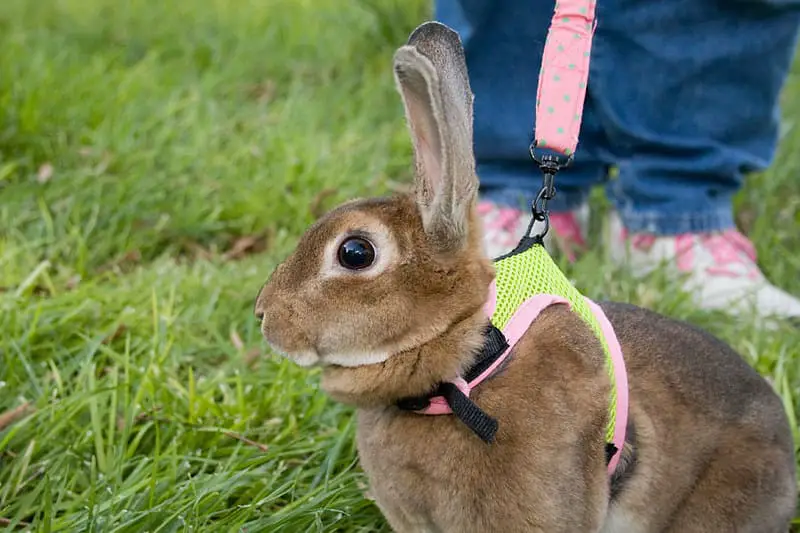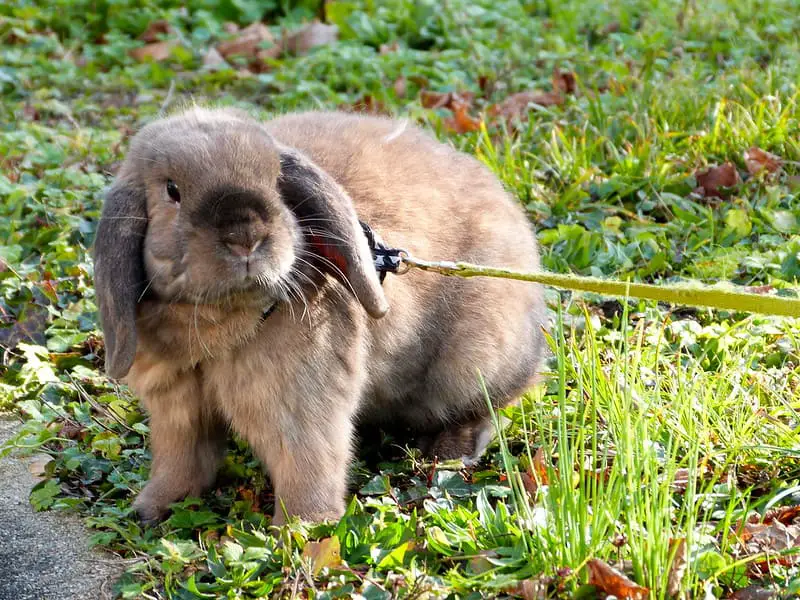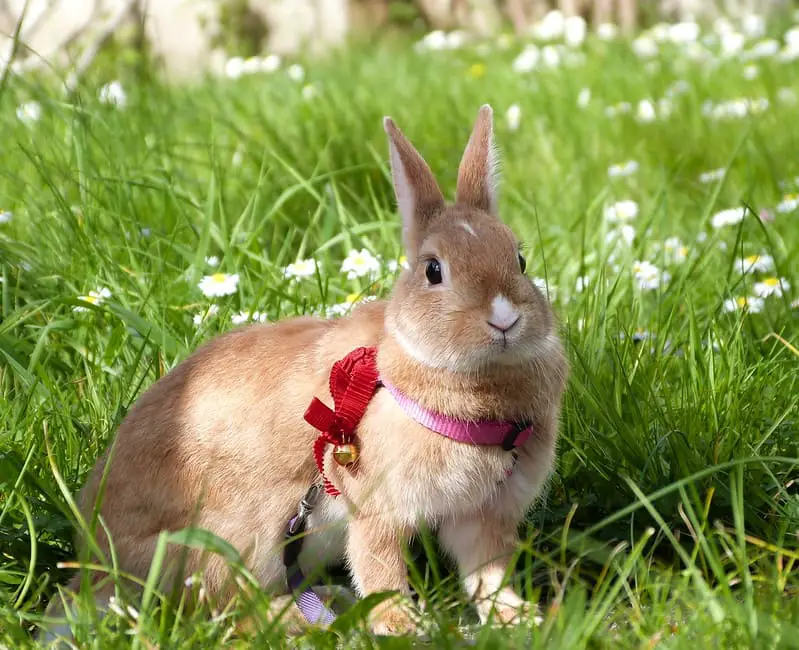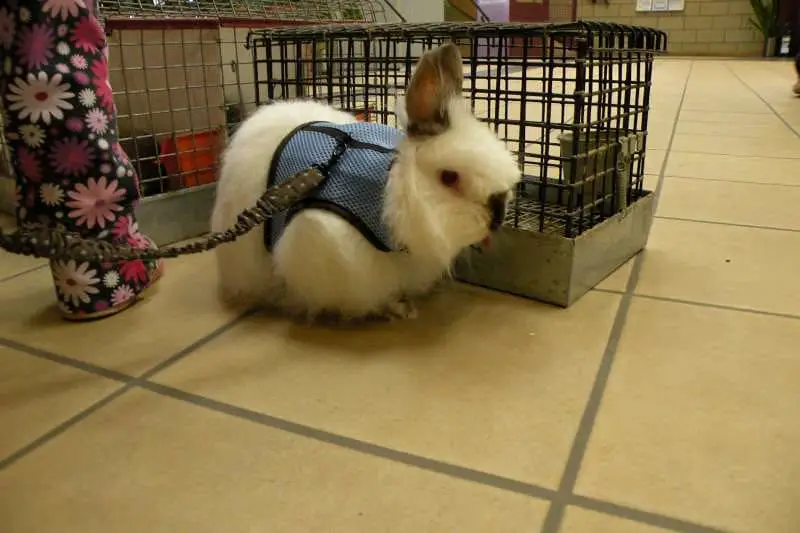Walking a rabbit in a harness is a subject of interest for many rabbit owners who want to provide their furry companions with extra exercise, mental stimulation, and outdoor exploration. While it’s not as common as walking dogs on a leash, it is possible to walk a rabbit in a harness if done correctly and with careful consideration of the rabbit’s safety and comfort. In this comprehensive guide, we will explore the topic of walking rabbits in harnesses, addressing the benefits, potential risks, the process of harness training, and important safety considerations.

The Benefits of Walking a Rabbit in a Harness
Before delving into the safety and training aspects, it’s important to understand the potential benefits of walking your rabbit in a harness. These benefits can vary depending on your rabbit’s personality and your goals, but they often include:
1. Exercise and Mental Stimulation
Rabbits are naturally active animals, and they require regular exercise to maintain their physical health and mental well-being. Walking your rabbit on a harness provides an opportunity for them to stretch their legs, explore new environments, and engage in physical activity.
2. Bonding
Walking your rabbit on a leash can be a great bonding experience for both you and your pet. It allows you to spend quality time together and develop a stronger connection.
3. Exploration
Rabbits are curious creatures, and they often enjoy exploring new environments. Walking in a harness allows your rabbit to experience the sights, sounds, and smells of the outdoors safely.
4. Controlled Outdoor Time
Walking your rabbit on a leash provides a controlled way for your pet to enjoy the outdoors. It minimizes the risks associated with free-roaming rabbits in an unsecured environment.
5. Enrichment
Outdoor walks can be mentally stimulating for rabbits, providing them with new sensory experiences and opportunities to investigate their surroundings.

Risks and Challenges of Walking a Rabbit in a Harness
While there are potential benefits to walking a rabbit in a harness, there are also several risks and challenges to consider:
1. Stress and Fear
Rabbits are sensitive animals, and they can easily become stressed or frightened by new experiences, unfamiliar environments, or the presence of predators. The harness itself may also be uncomfortable at first.
2. Escape Attempts
Rabbits are known for their agility and ability to wriggle out of tight spots. An improperly fitted harness or one that is not securely fastened can lead to escape attempts.
3. Predators
When outdoors, rabbits are at risk of encountering predators, such as birds of prey, dogs, cats, or wild animals. The presence of these threats can cause extreme stress to your rabbit.
4. Overstimulation
The outdoor environment can be overwhelming for rabbits. The noise, temperature variations, and exposure to unfamiliar sights and smells can lead to overstimulation and anxiety.
5. Temperature and Weather
Extreme weather conditions, such as high heat or cold temperatures, can be harmful to rabbits. They are susceptible to heatstroke in hot weather and can suffer from hypothermia in cold weather.
6. Dietary Concerns
When outside, rabbits may nibble on unfamiliar plants, some of which could be toxic. Overeating on grass or other vegetation can cause digestive problems, such as gastrointestinal stasis.
7. Escape Risks
Even if your rabbit remains secure in a harness, they can still be at risk of escaping if the harness becomes loose, damaged, or if your rabbit becomes frightened and attempts to slip out.
8. Legal Considerations
Depending on where you live, there may be local regulations or laws regarding keeping rabbits outdoors or walking them in public spaces.
Given the potential risks and challenges, it’s important to carefully consider whether walking your rabbit in a harness is suitable for your pet and your specific circumstances.

Harness Training: The First Steps
Before you can safely walk your rabbit in a harness, it’s essential to go through a harness training process. This process involves introducing your rabbit to the harness gradually and teaching them to wear it comfortably. Here are the first steps in harness training:
1. Choosing the Right Harness
Selecting the right harness is crucial. Look for a rabbit-specific harness that is designed to fit comfortably and securely. These harnesses are typically made of soft, lightweight materials that won’t constrict your rabbit’s movements. Avoid using harnesses designed for other animals, as they may not fit your rabbit properly.
2. Harness Introduction
Start by allowing your rabbit to become familiar with the harness without putting it on. Place the harness in your rabbit’s living area for a few days, so they can sniff it and explore it at their own pace.
3. Positive Associations
Associate the harness with positive experiences by placing a small treat or a piece of fresh vegetable on it. Your rabbit will learn to associate the harness with something enjoyable.
4. Initial Fitting
When your rabbit appears comfortable with the harness’s presence, it’s time to attempt to put it on. Make sure to choose a calm and quiet environment. Gently place the harness over your rabbit’s head, with one loop around the neck and the other around the chest. Adjust it for a snug but not tight fit. Allow your rabbit to move around while wearing the harness inside.
5. Short Sessions
Initially, keep the harness-wearing sessions short, gradually increasing the duration as your rabbit becomes more accustomed to it. During these sessions, offer praise and treats to reinforce positive behavior.
6. Leash Introduction
Once your rabbit is comfortable with the harness, you can introduce the leash. Attach the leash to the harness, and let your rabbit drag it around in a safe, supervised area. This helps your rabbit become accustomed to the feeling of having something attached to the harness.
7. Supervised Walks
When your rabbit is comfortable with the harness and leash, you can start with supervised walks in a secure, enclosed outdoor space. Use a harness specifically designed for rabbits, as it will allow for better control and safety.

Safety Considerations for Walking a Rabbit in a Harness
Walking a rabbit in a harness can be done safely with the right precautions and awareness of potential risks. Here are important safety considerations:
1. Secure Harness and Leash
Ensure that the harness is secure and properly fitted. It should be snug but not tight, with enough room for your rabbit to move comfortably. The leash should be attached securely to the harness to prevent escape.
2. Supervision
Always supervise your rabbit while they are wearing the harness and leash. Even in a secure area, rabbits can encounter unexpected situations or become frightened.
3. Quiet and Familiar Environment
Choose a quiet, familiar, and secure environment for your rabbit’s walks. Avoid noisy or high-traffic areas, as they can be stressful for your rabbit.
4. Avoid Predators
Be cautious about potential predators in the area. Keep an eye out for birds of prey, dogs, cats, or other animals that could pose a threat to your rabbit.
5. Temperature Considerations
Pay attention to the weather and temperature. Avoid walking your rabbit in extreme heat or cold, as rabbits are sensitive to temperature variations.
6. Rabbit’s Comfort
Regularly check your rabbit’s comfort level during walks. Ensure they are not showing signs of stress, fear, or overstimulation. If your rabbit seems uncomfortable, it’s best to end the walk and return to a safe space.
7. Health and Behavior
If your rabbit has any health concerns or behavioral issues, consult with a veterinarian before taking them for a walk. Some medical conditions or behavioral problems may make outdoor walks unsuitable.
8. Leash Length
Use a leash that allows your rabbit some freedom but maintains control. A long leash can pose tripping hazards, while a very short leash can limit your rabbit’s mobility.
9. Rewards and Positive Reinforcement
Use rewards and positive reinforcement to encourage good behavior during walks. Offer treats and praise when your rabbit behaves appropriately.
10. Regular Check-ins
Frequently check the harness, leash, and your rabbit’s overall well-being during the walk. Ensure that the harness remains secure and comfortable.
11. Education
Learn about rabbit behavior, body language, and signs of stress. This knowledge will help you understand your rabbit’s needs and comfort level during walks.
12. Be Ready to Retreat
Be prepared to end the walk and return to a safe environment if your rabbit shows signs of discomfort, fear, or stress. Your rabbit’s well-being should always be the top priority.
Signs of a Happy Rabbit During Walks
When walking your rabbit in a harness, it’s important to look for signs of a content and comfortable rabbit. Here are some positive indicators:
- Relaxed Body Language: A happy rabbit will exhibit relaxed body language, with ears in a neutral position, normal breathing, and no signs of tension.
- Curiosity: A curious rabbit will explore their surroundings, sniffing and investigating.
- Eating or Foraging: A content rabbit may nibble on grass or vegetation during the walk.
- Engagement: An engaged rabbit will show interest in their surroundings and may show signs of curiosity, such as periscoping (standing on hind legs to get a better view).
- Positive Interaction: If your rabbit approaches you or seeks your attention during the walk, it’s a sign that they are comfortable and enjoy your company.
- Relaxed Ears: Rabbit ears are a good indicator of their mood. If your rabbit’s ears are in a neutral position or slightly forward, it’s a sign of comfort.
- No Signs of Fear or Stress: A happy rabbit will not display signs of fear, such as cowering or rapid breathing. Stress may manifest as excessive grooming or thumping.
Conclusion
Walking a rabbit in a harness can be a rewarding experience, offering both physical activity and bonding opportunities. However, it’s crucial to prioritize your rabbit’s safety and comfort throughout the process. With proper harness training, supervision, and safety considerations, you can provide your rabbit with enjoyable outdoor walks while minimizing potential risks and challenges.
Remember that not all rabbits will enjoy or tolerate walking on a harness, and some may find it stressful. It’s essential to be attentive to your rabbit’s individual needs and preferences. If your rabbit doesn’t take to harness walking, there are plenty of other ways to provide exercise and mental stimulation, such as interactive toys, playtime, and safe outdoor enclosures. Ultimately, the goal is to ensure that your rabbit’s well-being and happiness come first in all aspects of their care.
